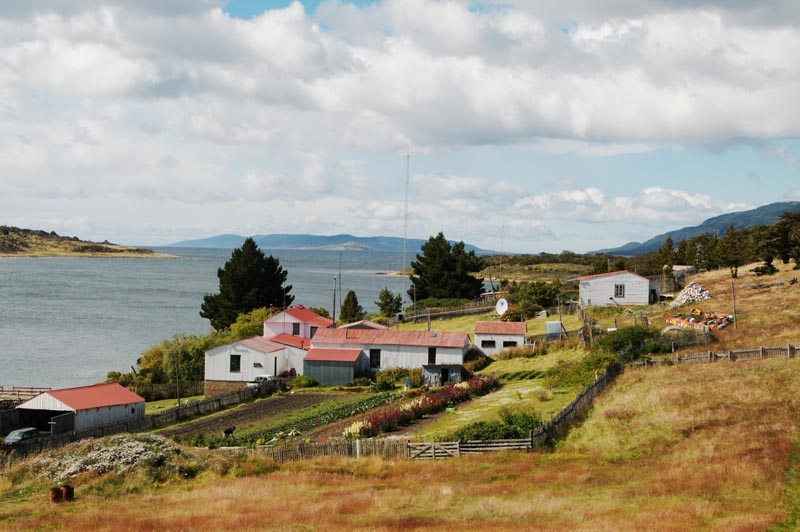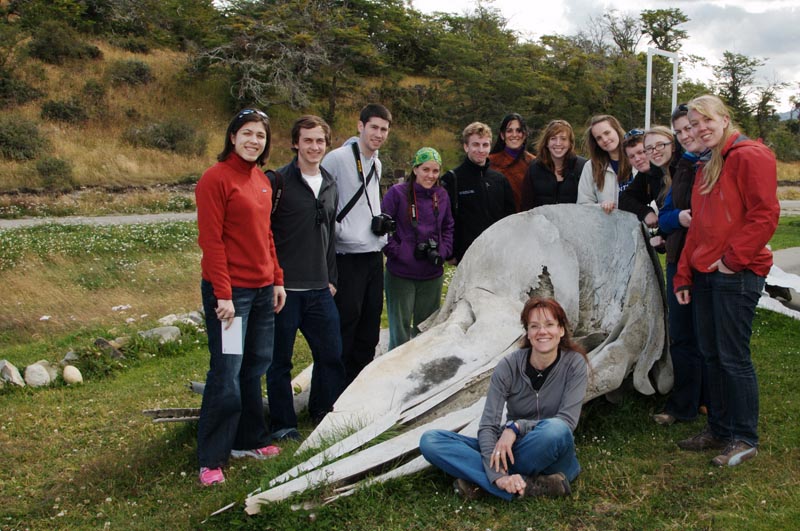Estancia Harberton (54° 52′ S / 67° 19′ W)
Today we started early and made the two hour journey through the beautiful Tierra del Fuego countryside to visit Estancia Harberton. The estancia (meaning farm) established by Thomas Bridges in 1887 is the oldest in the Argentinean Tierra del Fuego region and is named after his wife’s hometown (Harberton) in Devon, UK. The farm is currently managed by the 4th generation great-grandson, Thomas Goodall. We started our visit with a historic tour of the property, which really gave us a feel for what it would have been like to live in this remote region, and how the farm was run. It also gave us the opportunity to get some really great photos of the beautiful views and take advantage of the sunny weather. Lunch consisted of freshly prepared empanadas, risotto and apple pastries. After refuelling, we walked back along the track to visit the Acatushún Museum . For thirty-five years, the museum’s founder Natalie Goodall has helped to collect and preserve the skeletons of 2,700 stranded marine mammals and 2,300 birds. Our guide for the day, Kata, gave us a tour of the museum, and told us about the work carried out at the research centre and what has been learnt from analyzing the amazing bone collection. We were privileged to see many rare specimens, such as male and female spectacle porpoises as well as seven different species of beaked whales, including a complete skeleton of Hector’s beaked whale. To put this into context- there are only a handful of encounters reported with live Hector’s beaked whales, making this a really special collection. From the public display room Kata took us on a full tour of the facility which included the quarters where the researchers stay and the “bone house” where skeletons are cleaned and prepared for display.
Lunch consisted of freshly prepared empanadas, risotto and apple pastries. After refuelling, we walked back along the track to visit the Acatushún Museum . For thirty-five years, the museum’s founder Natalie Goodall has helped to collect and preserve the skeletons of 2,700 stranded marine mammals and 2,300 birds. Our guide for the day, Kata, gave us a tour of the museum, and told us about the work carried out at the research centre and what has been learnt from analyzing the amazing bone collection. We were privileged to see many rare specimens, such as male and female spectacle porpoises as well as seven different species of beaked whales, including a complete skeleton of Hector’s beaked whale. To put this into context- there are only a handful of encounters reported with live Hector’s beaked whales, making this a really special collection. From the public display room Kata took us on a full tour of the facility which included the quarters where the researchers stay and the “bone house” where skeletons are cleaned and prepared for display. We ended our trip by meeting with the researchers and students that intern at the museum to discuss what they were currently working on and exchange experiences. I personally found this to be an invaluable exercise and a real eye-opener. The Argentinean education system differs greatly to what we are used to back home, between 5 and 7 years to gain a degree due to difficulties in obtaining sufficient instruction and resources. Their university does not pay for their wide range of journal subscriptions, making it a struggle for students to gain access to primary literature- something I take for granted every day at St Andrews. The research centre at Estancia Harberton really provides a platform for their work and helps students gain with a wide and varied skill set that will stay with them for their scientific careers. Our trip today, finding out about the species in the collection and the people running it was fantastic, and has set a high standard for the rest of our adventure at el fin del mundo!
We ended our trip by meeting with the researchers and students that intern at the museum to discuss what they were currently working on and exchange experiences. I personally found this to be an invaluable exercise and a real eye-opener. The Argentinean education system differs greatly to what we are used to back home, between 5 and 7 years to gain a degree due to difficulties in obtaining sufficient instruction and resources. Their university does not pay for their wide range of journal subscriptions, making it a struggle for students to gain access to primary literature- something I take for granted every day at St Andrews. The research centre at Estancia Harberton really provides a platform for their work and helps students gain with a wide and varied skill set that will stay with them for their scientific careers. Our trip today, finding out about the species in the collection and the people running it was fantastic, and has set a high standard for the rest of our adventure at el fin del mundo!
(Jenn, SH Biology)
